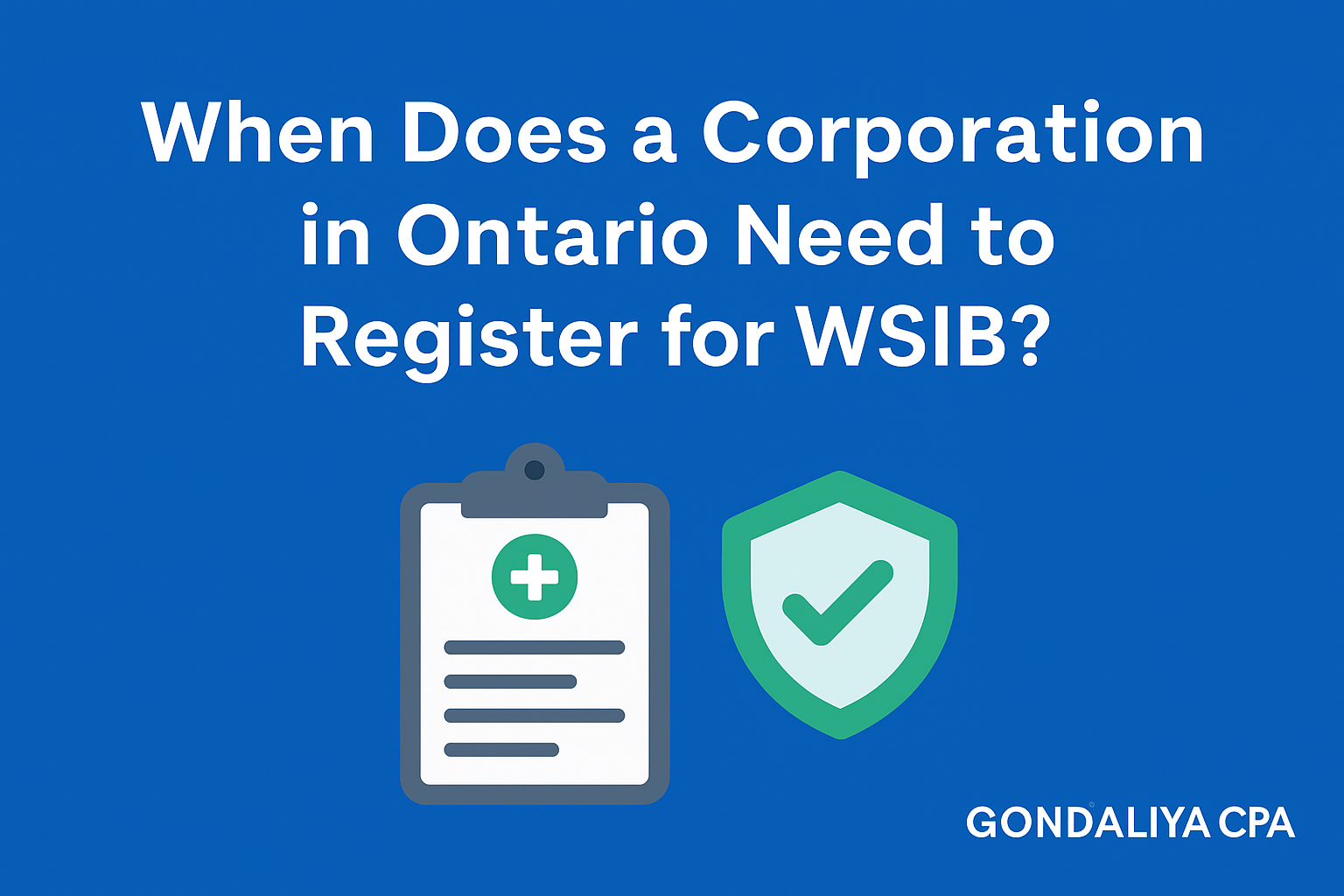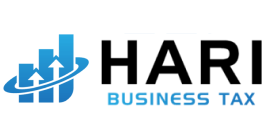When Does a Corporation in Ontario Need to Register for WSIB?
WSIB registration requirements Ontario corporation are essential for compliance and worker protection, and Gondaliya CPA provides clear guidance on how to register your business properly. With detailed information on WSIB rules and registration steps, we help your Ontario corporation meet all necessary obligations smoothly.
Request a Free Consultation
As a trusted tax accountant and business advisor, Gondaliya CPA helps corporations across Ontario understand not only their tax obligations but also compliance requirements like WSIB registration. Knowing when and how to register ensures your corporation stays compliant, protects your workers, and avoids penalties.
This guide explains everything you need to know about WSIB registration, including who needs to register, timing, exemptions, and how to integrate WSIB premiums into your bookkeeping and payroll systems.
Understanding Mandatory WSIB Registration for Ontario Corporations
What Is WSIB?

The Workplace Safety and Insurance Board (WSIB) is Ontario’s workplace compensation system, providing no-fault insurance coverage for workers who are injured or become ill because of their job. It also protects employers from lawsuits related to workplace injuries.
Why WSIB Matters to Corporations
- Compliance with Ontario workplace laws
- Financial protection from workplace accident costs
- Employee confidence and retention
- Reduced legal and financial risks
Who Must Register with WSIB?
Employers in certain fields must register with WSIB. The Employer Classification Manual tells who needs to sign up. If you hire employees, you usually have to register within a short time.
Mandatory Industries for WSIB Coverage
- Businesses in Schedule 1 industries—like manufacturing, transportation, retail, and most construction—must have coverage. It doesn’t matter how many workers they have.
- Manufacturing
- Transportation
- Retail
- Most construction sectors
WSIB Coverage for Executive Officers & Owners
Executive officers or directors aren’t always covered by WSIB unless they work in construction. Still, companies must register and cover other workers. Owners can buy optional insurance if they want extra protection.
Expanded Compulsory Coverage in Construction
Construction has extra rules. Executive officers, sole proprietors, and partners usually must register here. Some exemptions apply but are limited.
Core Requirements: When is WSIB Registration Triggered?
You need to know when the law says you have to register. Missing the deadline can bring big penalties.
The 10-Day Rule: Hiring Your First Employee
When you hire your first employee—full-time, part-time, casual, or even family—you have 10 calendar days to register with WSIB. Waiting longer isn’t a good idea.
Independent Contractors: Are They Employees for WSIB?
Sometimes independent contractors count as employees under WSIB rules. If you misclassify them, your business risks losing no-fault liability protection.
To sum it up: stick to these rules about mandatory WSIB registration for Ontario corporations. That way, your business stays safe and avoids trouble with the law.
How to Register Your Business with WSIB in Ontario
Most businesses in Ontario must register with the Workplace Safety and Insurance Board (WSIB). It’s a legal requirement. Doing this right keeps your business safe from fines and penalties.
Information You Need to Register Your Business
You’ll need some info before starting your WSIB registration. Having it ready saves time and avoids mistakes.
Company Information: Essential Details
Make sure you have:
- Your business’s legal name and address
- Federal Business Number (BN) or GST/HST number
- Industry type from the Employer Classification Manual
You must register within 10 calendar days after hiring your first worker. Missing this deadline can cause fines and extra charges. Ask your business accountant for help if you’re unsure.
Owner/Executive Details
Coverage rules vary for owners and executives:
- Executive officers usually don’t have automatic coverage unless they work in construction.
- Owners can choose optional insurance coverage through WSIB.
Give clear owner and executive info when registering to avoid confusion about who needs coverage.
Information About Your Employees
You’ll report:
- How many employees you have (full-time, part-time, casual)
- If family members work for the company
Family members count toward WSIB coverage. Reporting this correctly stops underreporting risks.
Payroll Information: Calculating Insurable Earnings
Your payroll affects how premiums get calculated. Provide:
- Total insurable earnings based on wages
- Salary details by job type
Premium rates differ by industry risk. Correct payroll numbers keep your premiums fair per WSIB rules.
A Step-by-Step Guide to WSIB Registration
Here’s how to register your business online with WSIB Ontario:
- Go to the official WSIB website.
- Create an employer account with your contact info.
- Enter your company details exactly as shown on documents.
- Use the Employer Classification Manual codes to classify your business.
- List all employees who must be covered by law.
- Submit estimated payroll info for premium calculations.
- Double-check everything before sending it off.
- Get confirmation of registration and login info for managing your account later.
Using a CPA firm can make these steps easier and help keep you compliant with workplace safety insurance rules in Ontario.
Register Your Business Online With Expert Assistance
Registering online is quick but tricky because of complex classification and payroll rules in workplace safety insurance Ontario programs.
A CPA firm can help you by:
- Giving advice that fits your business setup
- Calculating payroll properly using current premium rates
- Explaining which executives need optional insurance coverage
Working with corporate tax experts lowers the chance of errors that might lead to audits or penalties.
Related Links
For more on taxes linked to workplace safety insurance registration, check out resources from experienced corporate tax experts. They keep you updated on changing rules affecting Ontario businesses.
Navigating WSIB Policies and Guidelines
Understanding Your Legal & Financial Responsibilities
The Workplace Safety and Insurance Act, 1997 says Ontario companies must register with WSIB if they hire employees. It doesn’t matter if your worker is full-time, part-time, casual, or even a family member. You have to register within 10 calendar days after hiring the first employee. This rule applies if you work in a Schedule 1 industry.
If you don’t register, you risk big penalties like fines and paying back premiums for the time you weren’t covered. Also, without registration, your business loses no-fault liability protection. That means if someone gets hurt at work, you could get sued.
Make sure to check the latest employer classification manual from WSIB. It shows how industries are grouped and how your premiums are figured based on risk.
Policy Overview: Workplace Safety and Insurance Act & Employer Classification Manual
The Workplace Safety and Insurance Act controls workplace insurance in Ontario. It says most employers must cover their workers through WSIB unless the law says otherwise.
If your business is in a Schedule 1 industry, like manufacturing or construction, WSIB coverage is required no matter how many workers you have. The employer classification manual helps you find the right industry code. This keeps your premium fair based on what kind of work you do.
It’s smart to check these rules regularly so you don’t miss changes that could cost you later.
Guidelines for WSIB Registration in Ontario
- Register soon after hiring anyone.
- Keep clear records showing who works for you.
- Look at the employer classification manual often for any updates.
- Keep payroll records handy to report premiums correctly.
Following these steps keeps you safe from fines and makes sure workers get help if they get hurt.
If this sounds confusing, a CPA firm that knows corporate tax can help explain things or figure out premiums.
Common Registration Scenarios and Exceptions
Who needs to register isn’t always simple. Some cases are tricky:
- Executive officers (like owners or directors) usually don’t have to be covered unless they work in construction.
- Owners can choose “optional insurance” to get covered if they want.
- Subcontractors aren’t usually employees but it depends on contracts and how work is controlled under Ontario Employment Standards.
Check carefully before deciding if these people need WSIB coverage.
Others Who May Register: Executive Officers Coverage & Optional Owner Insurance
Usually, executive officers don’t have to join WSIB except in construction trades. But they can pick “optional insurance” if they want injury protection under WSIB rules even when not required by law.
This gives owners or directors extra safety beyond what mandatory employee coverage offers.
Exceptions: Expanded Compulsory Coverage in Construction
Construction has tighter rules:
- Sole proprietors,
- Partners,
- Executive officers,
They must carry WSIB insurance unless specific exceptions apply. These strict rules exist because construction is more dangerous than other jobs and accidents happen more often there.
By knowing these key policies about WSIB registration Ontario corporations face, businesses can follow the right steps. This protects workers and keeps companies safe from legal trouble.
Frequently Asked Questions (FAQs)
- Is a subcontractor considered an employee for WSIB purposes?
Usually no; subcontractors act independently unless contracts show control like an employee under Ontario Employment Standards. - Do non-profit corporations need to register with WSIB?
Yes—if they have workers in Schedule 1 industries without exemptions. - When must I register my corporation with WSIB?
Within 10 calendar days after hiring your first worker (full-time/part-time/casual/family). - Are executive officers automatically covered by WSIB?
Not usually outside construction; optional insurance is possible unless expanded compulsory rules apply (construction). - What happens if I fail to register my business?
Expect large penalties including fines and back payments plus loss of no-fault liability protection during unregistered time. - How does Schedule 1 affect my company’s obligation?
If in Schedule 1 industries like manufacturing or retail trade—you must keep active coverage no matter workforce size. - Can sole proprietors opt out of registering with WSIB?
Outside construction, yes; inside, sole proprietors mostly must register due to expanded compulsory coverage. - What resources help classify my industry correctly?
The WSIB employer classification manual gives official codes that affect premium rates. - Is there support available from accounting firms regarding WSIB compliance?
Yes; CPA firms focused on corporate taxes give advice on proper registrations and payroll aligned with law. - Does family employment trigger WSIB registration too?
Yes; hiring relatives counts toward the deadline for mandatory registration.
WSIB Compliance & Avoiding Penalties
Consequences of Employer Non-Compliance
In Ontario, corporations must register with WSIB within 10 calendar days after hiring their first employee. Missing this WSIB registration deadline can cause big problems. The Workplace Safety and Insurance Board will charge significant penalties for late registration. These fines grow the longer you wait.
If you don’t sign up on time, you’ll also face retroactive premium payments. This means you pay insurance fees going back to when coverage was needed but missing. These extra costs can hit your budget hard.
Even worse, not registering means you lose no-fault liability protection from WSIB. Without it, your business could be on the hook for workplace injury claims or lawsuits. That can get very expensive.
Skipping registration puts your company at risk for money losses and legal trouble. Registering on time keeps you safe and follows Ontario’s workplace safety rules.
Status Declaration Requirement – Construction
Construction has special WSIB rules because it’s a risky industry. There’s an expanded compulsory coverage in construction that covers all executive officers, sole proprietors, and partners automatically unless they ask for an exemption.
This is different from most other industries where execs or owners usually aren’t required to have coverage. In construction, these people must fill out a status declaration form to say who they are and if they want optional insurance when exempted.
For owners not in construction who want protection, WSIB lets them buy optional insurance for owners. This helps executives or partners get benefits like those under mandatory plans but on a voluntary basis.
Knowing these rules helps avoid mistakes with status declarations or missing insurance on workers who need it. Mistakes can lead to heavy penalties and problems with compliance.
For help figuring out WSIB rules, payroll, or your company’s status, reach out to Gondaliya CPA. Our tax pros offer clear advice for Ontario businesses that want to stay compliant without extra costs or risks.
Managing Your WSIB Account
Setting Up Accounts and Multiple Accounts
Setting Up Accounts
If your business hires workers in Ontario, you must do WSIB registration Ontario right away. It’s mandatory to open an account within 10 days of hiring your first worker. This applies to full-time, part-time, or casual staff. You’ll need to do correct payroll calculations to figure out how much to pay for premiums. Using the employer classification manual helps your business pick the right category so you pay the right rate.
Getting your account set up well means you follow the law and get protected by WSIB’s no-fault injury coverage.
- Register within 10 days after hiring first employee
- Calculate payroll accurately for premiums
- Use employer classification manual for correct rates
Multiple Accounts
Sometimes, businesses run different operations that need separate WSIB accounts. This helps keep things clear and organized for risks and reporting. Getting help from a business accountant support team or corporate tax experts makes this easier. They watch over payroll numbers across all parts of your business. That way, you avoid mistakes with classifications and premium payments.
- Separate accounts for different business lines
- Use accountant support for tracking payroll
- Avoid errors in premium payments
Authorizing Changes and Closing Accounts
Authorizing Changes
You must tell WSIB as soon as changes happen that affect your account. This includes hiring new people, letting staff go, or changing how your business works. Quick updates help keep injury reports accurate and stop mistakes in classifications that might cause fines.
Getting professional compliance assistance is smart when you need to approve changes like new owners or a new address. This keeps your coverage steady without gaps.
- Report new hires or terminations fast
- Update changes in business operations promptly
- Use compliance help for ownership or address changes
Closing Accounts
If your business stops working or no longer has workers covered by WSIB rules, you have to close your account properly. Not closing it can mean losing no-fault liability protection, leaving you open to lawsuits if someone gets hurt at work after closure.
Also, closing wrong can bring heavy penalties or back charges on premiums. Before you close an account, ask an expert so you don’t miss anything and avoid extra costs.
- Close account when no longer employing covered workers
- Avoid losing liability protection by closing properly
- Seek expert advice before closing to prevent penalties
Keeping up with your WSIB account protects your company from money troubles linked to workplace injuries and helps follow rules without issues. If you want help with registration, payroll calculations, or managing several accounts, talk to experienced corporate tax experts at Gondaliya CPA who know Ontario WSIB rules well.
Frequently Asked Questions (FAQs) on WSIB Registration Requirements
What is mandatory registration for WSIB in Ontario?
Employers in Schedule 1 industries must register with WSIB within 10 days of hiring their first worker. This ensures legal compliance and worker protection.
How does the employer classification manual affect WSIB premiums?
The manual assigns your business to a risk class. This classification determines your premium rate based on industry hazards and payroll size.
Who is covered under employee coverage requirements for WSIB?
All workers, including full-time, part-time, casual, and family members, require coverage unless exempted by law.
What is the process of premium rate calculation for WSIB?
WSIB calculates premiums using payroll amounts and risk classification codes from the employer classification manual.
Are executive officers coverage WSIB rules different from regular employees?
Yes. Executive officers are often excluded unless they work in construction. Optional insurance is available for them.
Can owners get optional insurance under WSIB?
Yes. Owners may purchase optional insurance to gain workplace injury benefits not covered by mandatory plans.
What does expanded compulsory coverage construction mean?
Construction has stricter rules requiring sole proprietors, partners, and executives to have WSIB coverage unless exempted.
When is the WSIB registration deadline?
Businesses must register within 10 calendar days after hiring their first employee to avoid penalties.
What are the significant penalties for failing to register with WSIB on time?
Penalties include fines, retroactive premium payments, and loss of no-fault liability protection that exposes businesses to lawsuits.
What are retroactive premium payments under WSIB rules?
These are charges for coverage during periods when a business failed to register but had employees working.
Why is no-fault liability protection important in WSIB compliance?
It shields employers from lawsuits when workers get injured on the job, provided they have active WSIB coverage.
How can business accountant support help with WSIB compliance?
Accountants ensure timely registration, accurate payroll reporting, correct classification, and manage ongoing compliance tasks efficiently.
What role do corporate tax experts play in WSIB registration?
They guide businesses on proper registration, payroll calculations, and understanding complex workplace safety insurance laws.
Why are payroll calculations crucial for WSIB premiums?
Accurate payroll numbers ensure fair premium rates and prevent costly overpayments or penalties.
How does workplace injury reporting relate to WSIB requirements?
Employers must report workplace injuries promptly to maintain compliance and support claims processing.
What should I know about WSIB account management after registration?
Maintain accurate records, update changes quickly, handle multiple accounts if needed, and close accounts properly when required.
Where can I find compliance assistance for managing my WSIB obligations?
CPA firms like Gondaliya CPA provide expert help in meeting all workplace safety insurance requirements effectively.
Key Points on WSIB Compliance Essentials
- Mandatory registration applies within 10 days of hiring your first worker.
- Use the employer classification manual to determine your industry code.
- Employee coverage includes all types of workers unless specific exemptions apply.
- Premium rate calculation depends on your payroll and classification.
- Executive officers often require optional insurance unless in construction.
- Owners can buy optional insurance for added protection.
- Construction industry faces expanded compulsory coverage rules.
- Missing the WSIB registration deadline leads to significant penalties.
- Retroactive premium payments may be charged for late registrations.
- No-fault liability protection prevents costly lawsuits after workplace injuries.
- Business accountant support helps manage payroll and filings accurately.
- Corporate tax experts clarify complex workplace safety insurance laws.
- Accurate payroll calculations reduce risk of audits or overpayment.
- Prompt workplace injury reporting supports claims and maintains compliance.
- Managing your WSIB account requires timely updates and correct closures.
- Compliance assistance ensures ongoing adherence to evolving regulations.
How Gondaliya CPA Can Help You with WSIB Compliance
Gondaliya CPA: Your Corporate Tax Experts for WSIB Compliance
Handling WSIB registration Ontario can feel tricky. Gondaliya CPA is a reliable CPA firm that helps you follow all the rules. We make sure your company registers on time and avoids fines.
We explain what you need based on your type of business and how many people you have working. Whether you work in retail, manufacturing, or construction, we help you figure out if you fall under Schedule 1 industries. Plus, we look after coverage for your executive officers, so nothing gets missed.
Here’s how we help:
- Explain WSIB rules simply
- Tell you when to register
- Avoid penalties
- Protect coverage for owners and officers
You get peace of mind knowing your company meets WSIB laws fully.
Ensuring Accurate Payroll Calculations with Your Business Accountant
Correct payroll calculations matter a lot for WSIB premiums. Our skilled business accountant team checks payroll carefully. We make sure employee types and hours are right. That way, you don’t pay too much or get hit with surprise bills later.
Our tax accountants help link your payroll system to WSIB reports too. This keeps things smooth and less work for you.
Why work with us?
- Fix payroll data precisely
- Match payroll with WSIB needs
- Cut down admin stress
- File on time with proper documents
A good accounting team like ours helps keep your spot safe with the Workplace Safety & Insurance Board. Give us a shout to see how our corporate tax experts make WSIB registration Ontario easy for your business.

Sharad Gondaliya CPA Canada and CPA USA having 14 Years+ experience of Accounting, Tax, Payroll of Corporate Small Businesses as Tax Accountant. He is fully certified CPA Ontario and CPA USA. He is well known amoung Corporate Small Businesses for Tax Planning, efficient Tax solutions and for Affordable CPA services, He is Principal (Director) at Gondaliya CPA – Affordable CPA in Canada.




